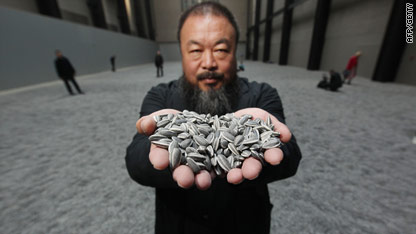Scammer
Banned

Visitors to the Tate Modern gallery in London on Friday have been stopped from walking on a porcelain sunflower seed art installation by the maverick Chinese artist Ai Weiwei.
Members of the public had previously been encouraged to interact with the installation by walking among and handling the 100 million hand-crafted porcelain seeds.
But Tate officials now say that walking on the artificial seeds, which lay in an inch-thick carpet in the gallery's massive Turbine Hall, has generated more dust than expected.
"Although porcelain is very robust, the enthusiastic interaction of visitors has resulted in a greater than expected level of dust in the Turbine Hall. Tate has been advised that this dust could be damaging to health following repeated inhalation over a long period of time.
"In consequence, Tate, in consultation with the artist, has decided not to allow visitors to walk across the sculpture," the statement by Tate Modern said.
The installation is still open to the public, who can view the replica seeds from a first floor platform.
A spokesman for Tate Modern told CNN that the public are unlikely be allowed to interact with the exhibit again.
This is not the first time the gallery has experienced problems with an exhibit in the Turbine Hall.
In 2006 the Tate had to hand out cloth sacks to visitors for an exhibition that consisted of metal slides by the artist Carsten Höller. Officials were worried that members of the public could experience burns on the slides.
And in 2007 the gallery had to put up warning signs for a sculpture by Doris Salcedo called Shibboleth -- a huge artificial crack in the floor of the Turbine Hall.
The sculpture by Ai -- described by some as China's "Andy Warhol" -- is the 11th commission in the internationally acclaimed Unilever Series at the gallery, an annual series kicked off in 2000 by Louise Bourgeois's spiders and mirrors.
Ai's seeds are porcelain, each one individually handcrafted by laborers in the Chinese city of Jingdezhen. Each tiny piece has been individually molded and hand-painted, according to the gallery.
Sunflower seeds are a popular Chinese street snack and one of the country's most famous exports, according to the gallery. But they hold greater significance for Ai, who spent his childhood in Xinjiang as the son of a celebrated poet exiled by the Chinese communist government during the Cultural Revolution.
He told CNN: "It was very poor and rural there, we had nothing else to enjoy. Sunflower seeds were something basic that everyone could have. Every holiday, wedding or even just going to the movies, we would all share sunflower seeds with one another.
I think it's a very common, very inconspicuous object, but it also has a special relationship to our daily lives ... Of course, during the cultural revolution we all knew that the Sun symbolized the leader, and sunflowers represented the people. So I think these seeds carry multiple meanings."
Ai is a well-known and controversial figure in China, probably best-known today for the design -- in collaboration with Herzog & de Meuron -- of Beijing's "Bird's Nest" stadium, built for the 2008 Olympics.
Shortly after, Ai -- who is one of China's leading social activists and bloggers -- distanced himself from the Olympics calling for a boycott and saying the Chinese government was using them as propaganda.
In the 1990s, Ai came to international attention when he helped establish the avant-garde East Village in Beijing where a group of artists took up residence in impoverished migrant workers housing on the city's outskirts. It became a Mecca for radical Chinese contemporary artists like Ma Liuming.
Other notable large-scale artworks that have filled the Tate Modern's Turbine Hall include Carsten Hollers' slides which had visitors shouting with excitement as they slid down; Olafur Eliasson's giant projection of the sun in "The Weather Project" and a huge crack in the floor courtesy of Doris Salcedo's "Shibboleth."
